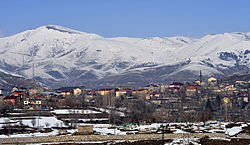Bitlis
| Bitlis | |
|---|---|
| Municipality | |

Bitlis Views
|
|
| Coordinates: 38°24′00″N 42°06′30″E / 38.40000°N 42.10833°ECoordinates: 38°24′00″N 42°06′30″E / 38.40000°N 42.10833°E | |
| Country | Turkey |
| Province | Bitlis |
| Government | |
| • Mayor | Hüseyin Olan (HDP) |
| Area | |
| • District | 1,128.14 km2 (435.58 sq mi) |
| Elevation | 1,545 m (5,069 ft) |
| Population (2012) | |
| • Urban | 46,111 |
| • District | 64,725 |
| • District density | 57/km2 (150/sq mi) |
| Website | www |
Bitlis (Armenian: Բաղեշ Baghesh/Paghesh;Kurdish: Bidlîs; Syriac: ܒܝܬ ܕܠܝܣ Beṯ Dlis; Ottoman Turkish: بتليس) is a city in eastern Turkey and the capital of Bitlis Province. The city is located at an elevation of 1,545 metres, 15 km from Lake Van, in the steep-sided valley of the Bitlis River, a tributary of the Tigris. The local economy is mainly based on agricultural products which include fruits, grain and tobacco. Industry is fairly limited, and deals mainly with leatherworking, manufacture of tobacco products as well as weaving and dyeing of coarse cloth. Bitlis is connected to other urban centres by road, including Tatvan on Lake Van, 25 km to the northeast, and the cities of Muş (Mush), 100 km northwest, and Diyarbakır, 200 km to the west. The climate of Bitlis can be harsh, with long winters and heavy snowfalls. Summers are hot, and often humid.
The origin of the name Bitlis is not known. A popular folk etymology explanation, without historical basis, is that it is derived from "Lis/Batlis", the name of a general said to have built Bitlis castle by the order of Alexander the Great. To Armenians, it was known as Balalesa or Baghaghesh, and later Baghesh. According to one popular Armenian folk story, on a cold, wintry day a donkey left its stable and wandered down the valley below. The donkey died of the freezing temperatures and was only discovered in the spring, once the ice had melted; thus, it received the name Pagh Esh, or "Cold Donkey."
Baghesh was one of the most important cities of the Kingdom of Armenia's province of Aghdznik', and it served as the primary fortress of the province's canton of Salnodzor. Some medieval Armenian writers, such as Anania Shirakatsi and Vardan Areveltsi, later mention it as a part of the canton of Bznunik'. The fortress guarded the Baghesh Pass, which linked the southern reaches of the Armenian Plateau to northern Mesopotamia. The Arabs conquered Baghesh at the end of the seventh century and it eventually became the capital of the Zurārid emirs of Aghdznik'. Because it was on an important trade route, it prospered greatly.
...
Wikipedia

